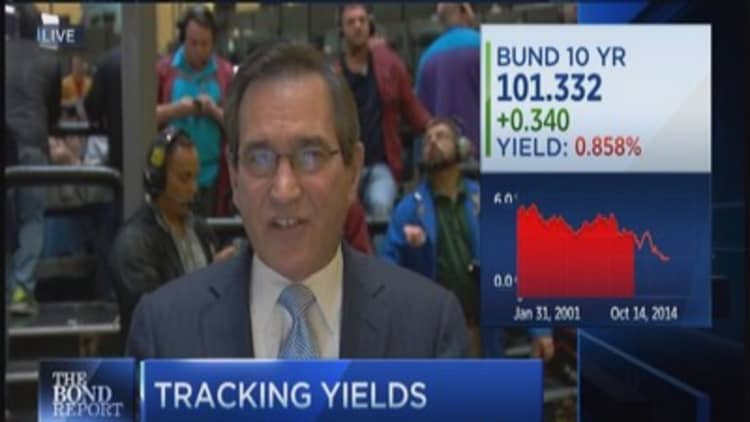
If scary markets frighten you as much as scary movies, then you might want to keep your hands over your eyes for a while longer yet.
Though stocks staged a rally Tuesday, the issues that have bedeviled the market in 2014 haven't really gone away, in much the same way that horror movie legends Jason Voorhees, Michael Myers and Freddy Krueger seemed to keep coming back.
"Just when you think the selloff couldn't get any scarier, it did," Nick Colas, chief market strategist at ConvergEx, said Tuesday in a note to clients, the day after a frenzy of late-day selling brought the market to yet another negative close. The has lost 5.2 percent over the past month and is up a scant 1.9 percent for the calendar year.
Colas doesn't believe the selling is over yet, and in fact compiled a "top 10" list in an effort to provide some concrete signals that the 5½-year bull run is ready to resume.
"Bottom line: this is unlikely to be a dramatic 'V-bottom' low given the range of issues of concern to investors," he said. "Look for the majority of our 'Top 10' to stop going down before calling a bottom."

The list, in slightly abbreviated form:
1. Watch the VIX: The has doubled over the past three months, though it remains at a historically modest level around 24. Colas thinks the VIX—a widely cited gauge of market fear—would have to get at least to 26 and perhaps to 32 before that would indicate a fear top.
Read MoreAfter VIX 'super spike,' is the worst ahead?
2. Bond yields: While most of Wall Street thought government debt yields would rise this year, they've actually fallen amid fears of global deflation. Colas didn't pick a specific point, but said the general direction should be higher before indicating slowdown worries have subsided.
Read MoreGundlach: We've put in a bottom on interest rates
3. Small-cap stocks: The index is already in correction territory when compared with the all-time peak it saw in early July and has fallen 8.7 percent year to date. More troubling, it has shown a strong divergence from the S&P 500. "Small caps need to show better performance to give investors confidence that we have made a bottom in large caps," Colas said. "Enough of the divergence—both asset classes have to start acting more consistently with respect to their common fundamentals."
4. Exchange-traded funds: Flows from ETFs have slowed in October, Colas said, with the $1.8 trillion space losing $5.7 billion so far on the equity side and gaining $8.2 billion in fixed income safe havens. "You will want to see money flowing into this space before you ring the all-clear on the recent pullback," he said.
5. Oil prices: Crude is down 14.4 percent in 2014, providing consumers a break with sub-$3 a gallon gas in many locations, but also could be indicative of declining demand due to slowing economic activity. Look for a line in the sand at $80 a barrel.
Read MoreLower oil is not all good news: Art Cashin
6. Europe: Economic data out of the euro zone, even in strongholds like Germany, has been pretty awful. The headline tone needs to change, in particular regarding central bank plans to spur growth.
7. The dollar: The U.S. greenback has been on a surge, which in itself could be a good sign. Colas said the main problem, however, is volatility. "In truth, what we need to see is a stable dollar at whatever level it chooses," he said. "That will be a sign of a bottom, in that investors will have set some kind of equilibrium from which they can begin to choose between different asset classes."
8. Trading volumes: Market participation has been a weak point for years, particularly since the 2010 "flash crash." The downturn actually has accelerated trading activity, with TABB Group reporting that exchanges saw a 16 percent month-over-month gain in volume. Colas advises looking for a plateau before the bottom.
9. Hedge funds: "I can assure you that the bottom tick of the current pullback will be from some hedge fund letting go of their last favorite—but losing—stock position," Colas said. "So look for signs of distress in the hedge fund community—perhaps including chatter of a high-profile closure or two—as a signal that stocks have actually hit their low points."
10. Ebola, ISIS et al: Colas advises that anyone who believes Ebola will become a global pandemic, or that ISIS rebels will take over the Middle East, should invest in "gold, Glocks and canned food." Otherwise, despite their threat to world peace and health, they're not really major market themes.
Read MoreMark Zuckerberg donates $25 million to fight Ebola
"Realize that the Middle East has been a mess longer than just the arrival of ISIS on the scene. And Ebola is just one more stanza in the sad song of diseases that kill innocent human life," he said.
"For the moment, however, fear has the upper hand and we have to respect that. That's why this list has 10 items, rather than just this last one. 'Ebola cured' or 'ISIS defeated' are not going to be headlines in 2014. Or likely in 2015 or 2016 for that matter. The other nine of our top 10 will have to deliver the signal that these larger worries are discounted in stock prices."






